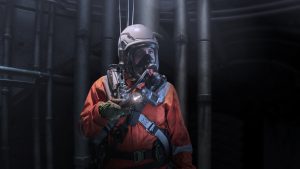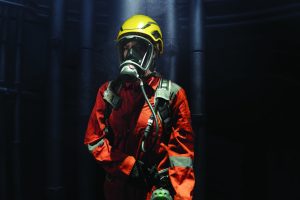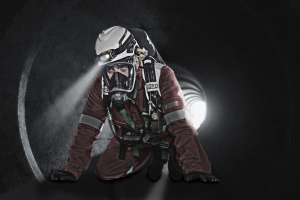Confined spaces pose significant safety challenges in industries like oil refineries, petrochemical plants, and gas refining operations. These environments often have limited entry and exit points, poor ventilation, and heightened risks of hazardous substances. Despite the dangers, confined spaces remain essential for tasks such as maintenance, inspection, and repairs.
In this article, we explore the primary hazards associated with confined space entry and discuss best practices to mitigate these risks. Additionally, we’ll highlight how PSA Africa’s products can play a crucial role in ensuring the safety of workers in confined spaces.
Table of Contents
Oxygen Deficiency
One of the most critical hazards in confined spaces is oxygen deficiency. Normal air contains approximately 21% oxygen, but confined spaces, especially in petrochemical and gas industries, may contain less due to displacement by gases such as nitrogen or carbon dioxide. An oxygen level below 19.5% can cause disorientation, unconsciousness, and, in extreme cases, death.
MITIGATION:
- Gas Detectors: Regular monitoring of oxygen levels with gas detection equipment is essential. PSA Africa offers fixed and portable gas detectors that can continuously measure oxygen levels and provide real-time alerts if they fall below safe thresholds.
- Ventilation Systems: Use portable ventilators to introduce fresh air into the confined space before and during the work process. Ensure the area is properly ventilated to maintain a safe oxygen concentration.
- SCBA Systems: When working in low-oxygen environments, workers should be equipped with Self-Contained Breathing Apparatus (SCBA), like the MSA M1 SCBA, available through PSA Africa, to ensure they have a constant supply of breathable air.
Toxic Atmospheres
Many confined spaces in oil refineries and gas plants contain toxic gases such as hydrogen sulphide (H₂S), methane, or carbon monoxide. These gases are not only harmful to workers but are often odourless and colourless, making detection without proper equipment impossible.
MITIGATION:
- Multi-Gas Detection Systems: Workers entering confined spaces should always use multi-gas detectors to check for toxic gases. PSA Africa’s MSA Altair 4XR Multi-Gas Detector offers reliable monitoring of up to four gases simultaneously, ensuring that toxic atmospheres are detected early.
- Continuous Monitoring: Even after an initial safety check, continuous gas monitoring is necessary, as gases can accumulate or be released unexpectedly due to temperature changes or equipment malfunctions.The Altair 5X gas detector is designed for initial testing.
Flammable Atmospheres
Confined spaces in oil and gas plants are at high risk of flammable atmospheres. Vapours from petroleum, natural gas, or other chemicals can create explosive mixtures. Even a small spark from electrical equipment or static can trigger a devastating explosion.
MITIGATION:
- Explosion-Proof Equipment: Ensure all equipment used in confined spaces, such as lights or fans, is explosion-proof to minimise the risk of sparks igniting flammable vapours.
- Gas Detection with LEL Monitoring: Install Lower Explosive Limit (LEL) monitors to measure the concentration of flammable gases. PSA Africa’s MSA Galaxy GX2 LEL Detector is designed to detect dangerous gas levels and prevent explosions in confined spaces.
- Grounding Procedures: Implement proper grounding and bonding procedures when working with flammable materials to prevent static build-up.
Engulfment Hazards
Engulfment hazards arise when materials such as liquids, gases, or solids (like sand, grain, or other bulk materials) can flow into a confined space and trap or suffocate workers. This is particularly a risk in tanks, pipelines, or storage vessels.
MITIGATION:
- Barrier Systems: Use proper barriers and isolation techniques to prevent materials from flowing into confined spaces while work is being carried out.
- Work Permits and Procedures: Ensure that a confined space entry permit system is in place, and workers are trained on emergency exit procedures in case of engulfment risks.
Physical Hazards
Confined spaces often contain machinery, pipes, or other structural hazards that can cause injury through entrapment, crushing, or falls. In addition, these spaces may have slippery surfaces, sharp edges, or inadequate lighting, increasing the risk of injury.
MITIGATION:
- Personal Protective Equipment (PPE): Ensure workers wear appropriate PPE, including head protection, eye protection, and slip-resistant footwear, to minimise injury risks. PSA Africa supplies a wide range of PPE, including hard hats, safety goggles, and protective clothing, designed for workers in high-risk environments.
- Confined Space Safety Training: Provide comprehensive training for workers to familiarise them with the potential physical hazards and how to avoid them. Regular drills should also be conducted to ensure workers are prepared for emergencies.
Best Practices for Confined Space Safety
In addition to addressing these hazards, there are overarching best practices that all refineries, petrochemical, and gas plants should implement:
- Pre-Entry Risk Assessment: Always conduct a thorough risk assessment before any confined space entry. This should include air quality testing, an evaluation of the space’s structural integrity, and an inspection of all equipment.
- Communication Systems: Establish reliable communication systems so workers inside confined spaces can easily contact external teams in case of emergencies.
- Emergency Response Plans: Every confined space operation should have a detailed emergency response plan, complete with rescue procedures and access to rescue equipment.
Conclusion
Working in confined spaces in oil refineries, petrochemical plants, and gas refineries is fraught with risks, from oxygen deficiency to flammable atmospheres. However, by adopting the right safety measures and using high-quality safety equipment like the gas detectors, SCBAs, and PPE offered by PSA Africa, these hazards can be effectively managed. Always prioritise worker safety and ensure that best practices are adhered to for every confined space entry.
For more information on safety solutions for confined spaces, visit PSA Africa.

Top Risks in Confined Spaces: Key Hazards and Best Practices for Oil, Petrochemical, and Gas Refineries
This whitepaper considers the different Confined Space Entry (CSE) challenges, highlighting features and characteristics that define best-in-class practices and solutions.

Are You Prepared with Respiratory Protection For Confined Space Applications?
Hazardous atmospheres are often found within confined spaces. Hazardous conditions can include oxygen deficiency and atmospheric concentrations which make a confined space immediately dangerous to

Confined Space Entry (CSE): Safe work in confined spaces demands a fully-integrated approach
This whitepaper considers the different Confined Space Entry (CSE) challenges, highlighting features and characteristics that define best-in-class practices and solutions.
